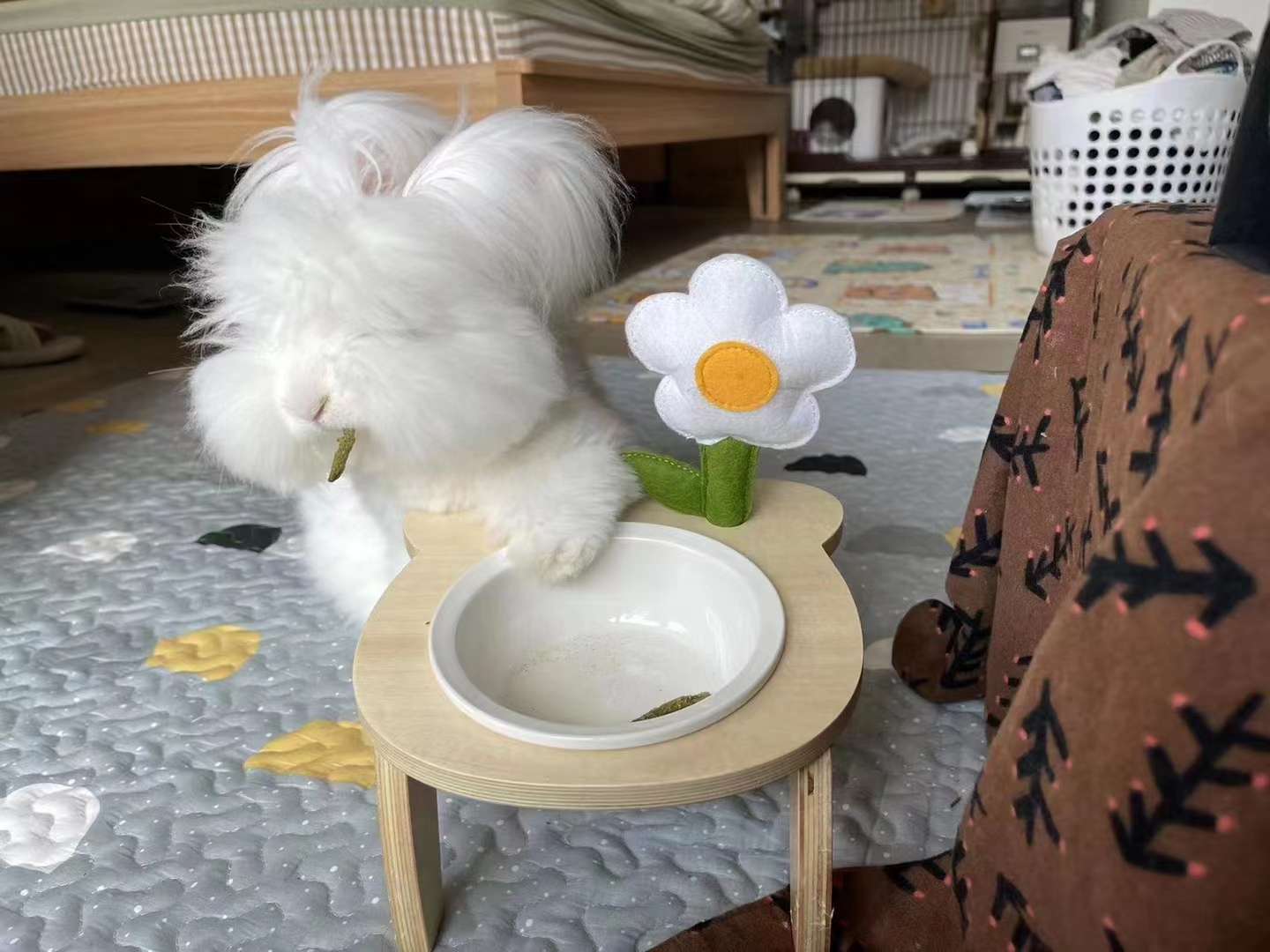

蒙阴长毛兔:养殖场夏季存活率提升策略
 发布日期:2025-07-11
来源:http://www.myxinhua.com 发布人:创始人
发布日期:2025-07-11
来源:http://www.myxinhua.com 发布人:创始人
夏季高温高湿环境对长毛兔生存挑战显著,其浓密被毛和不耐热特性易引发中暑、食欲下降等问题。通过科学调控环境与优化管理,可有效提升存活率。
The high temperature and humidity environment in summer poses significant challenges to the survival of long haired rabbits, as their dense fur and heat intolerance can easily lead to problems such as heatstroke and decreased appetite. By scientifically regulating the environment and optimizing management, the survival rate can be effectively improved.
环境降温是核心。兔舍温度需控制在 30℃以下,外界超 32℃时启动降温措施:顶部搭建遮阳棚(用遮光率 70% 以上的遮阳网或秸秆),减少阳光直射;舍内装喷雾系统,每日 10 点 16 点每 2 小时喷雾 1 次,将湿度控制在 60%-70%(防皮肤病)。规模养殖场可在兔舍两端装排风扇,保持 0.5-1 米 / 秒风速加速散热;兔笼底部铺竹制漏粪板减少地面传热,笼具上方挂湿毛巾通过蒸腾降温。
Environmental cooling is the core. The temperature of the rabbit house should be controlled below 30 ℃. When the external temperature exceeds 32 ℃, cooling measures should be taken: a sunshade should be built on the top (using a sunshade net or straw with a shading rate of over 70%) to reduce direct sunlight; The house is equipped with a spray system. spray once every 2 hours from 10:00 to 16:00 every day to control the humidity at 60% -70% (to prevent skin diseases). Large scale breeding farms can install exhaust fans at both ends of the rabbit house to maintain a wind speed of 0.5-1 meters per second to accelerate heat dissipation; The bottom of the rabbit cage is covered with bamboo leakage boards to reduce ground heat transfer, and wet towels are hung above the cage to cool down through transpiration.
毛发管理助力散热。入夏前剪毛,保留 3-4 厘米(兼顾保护与散热),间隔 40 天二次剪毛防被毛过厚。剪毛动作轻柔防皮肤划伤,剪后笼内放少量干草减少皮肤与笼具摩擦。临产母兔产前 1 周修剪腹部和乳房周围毛发,既利散热又方便幼兔哺乳。
Hair management helps with heat dissipation. Trim the hair for the first time before entering summer, keeping 3-4 centimeters (to balance protection and heat dissipation), and cut it twice every 40 days to prevent excessive hair. The shearing action is gentle to prevent skin scratches, and after cutting, a small amount of hay is placed in the cage to reduce friction between the skin and the cage. Trim the hair around the abdomen and breasts of pregnant rabbits one week before delivery, which not only helps with heat dissipation but also facilitates breastfeeding for young rabbits.
饮食调整抗热应激。增加青绿多汁饲料(苦荬菜、苜蓿草等)占比 30%-40%,补充水分并刺激食欲;精饲料加 1%-2% 植物油提能量,减粗糠等高热饲料。保证清凉饮水,添加 0.3% 电解多维或 1% 淡盐水补电解质,水温控制在 10-15℃(储水桶包隔热棉)。喂食改在清晨 5 点和傍晚 19 点后,避开高温时段,每次喂食量减 10%、增 3-4 次 / 日,防饲料变质。
Dietary adjustments to resist heat stress. Increase the proportion of green and juicy feed (such as amaranth and alfalfa) to 30% -40%, supplementing water and stimulating appetite; Adding 1% -2% vegetable oil to concentrated feed to increase energy, and reducing high calorie feed such as coarse bran. Ensure cool drinking water, add 0.3% electrolytic multidimensional or 1% diluted salt water to replenish electrolytes, and control the water temperature at 10-15 ℃ (with insulation cotton wrapped in the water storage tank). Feeding should be changed to after 5am and 7pm, avoiding high temperature periods. The feeding amount should be reduced by 10% each time and increased to 3-4 times per day to prevent feed spoilage.

把控饲养密度与卫生。成年兔笼具空间不低于 0.5 ,幼兔 0.2 以上,减拥挤产热。每日清粪便和残料,每周用 0.1% 过氧乙酸 1 次,清洁笼具缝隙和饮水器防肠道病。发现精神萎靡、呼吸超 80 次 / 分钟的兔,立即移阴凉处,用湿毛巾擦耳郭和腹部降温,灌 5-10 毫升藿香正气水。产后母兔产箱铺干稻草,保持安静防弃仔。
Control feeding density and hygiene. The space for adult rabbit cages should not be less than 0.5 square meters, and for young rabbits it should be at least 0.2 square meters to reduce crowding and heat production. Clean feces and residues daily, disinfect once a week with 0.1% peracetic acid, and focus on cleaning the gaps between cages and water dispensers to prevent intestinal diseases. If a rabbit is found to be mentally lethargic and breathing more than 80 times per minute, immediately move it to a cool place, wipe the earlobes and abdomen with a damp towel to cool down, and administer 5-10 milliliters of Huoxiang Zhengqi Water. After giving birth, the mother rabbit's litter box is covered with dry straw and kept quiet to prevent littering.
同步做好应激管理与疾病预防。兔舍周围种薄荷、艾草,其挥发物缓解兔群紧张。避开正午转群、接种等操作减人为应激。定期查皮肤,发现脱毛、红斑及时隔离病兔,涂克霉唑软膏防真菌病。饲料加 0.1% 大蒜素增强肠道力,降低腹泻率。储备十滴水、清凉油等防暑药,制定急救预案。
Synchronize stress management and disease prevention. Peppermint and mugwort are planted around the rabbit house, and their volatile compounds relieve the tension of the rabbit herd. Avoid midday group switching, vaccination, and other operations to reduce human stress. Regularly check the skin, isolate sick rabbits in a timely manner if depilation or erythema is found, and apply clotrimazole ointment to prevent fungal diseases. Adding 0.1% allicin to feed enhances intestinal antibacterial activity and reduces diarrhea rate. Reserve ten drops of water, cooling oil and other heatstroke prevention drugs, and develop emergency plans.
通过上述措施,可多维度构建防暑体系,降低热应激伤害,保障夏季存活率稳定在 90% 以上。
Through the above measures, a multi-dimensional heatstroke prevention system can be constructed to reduce heat stress injuries and ensure a stable summer survival rate of over 90%.
本文由蒙阴长毛兔友情奉献.更多有关的知识请点击:http://www.myxinhua.com我们将会对您提出的疑问进行详细的解答,欢迎您登录网站留言.
This article is a friendly contribution from Long haired Rabbit For more information, please click: http://www.myxinhua.com We will provide detailed answers to your questions. You are welcome to log in to our website and leave a message